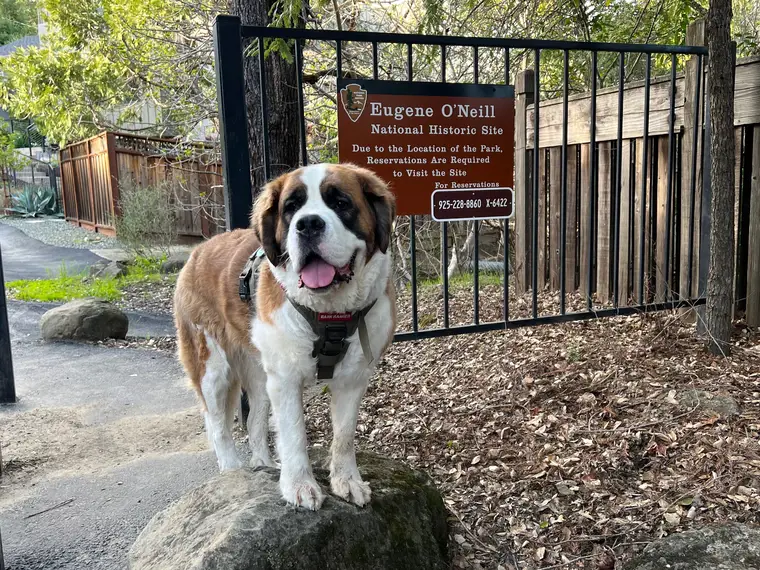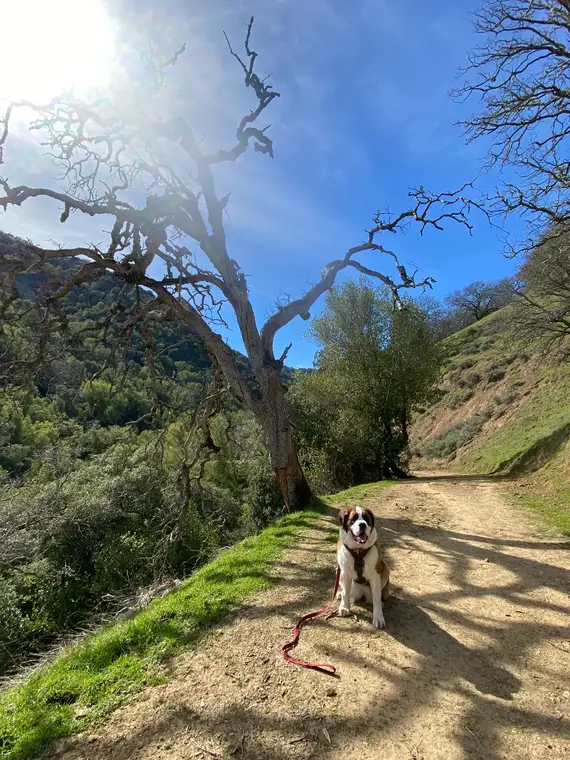Eugene O'Neill Dog Policy
Eugene O'Neill National Historic Site is Somewhat Dog Friendly
Eugene O'Neill National Historic Site preserves the home and history of Eugene O'Neill, the United States' only Nobel Prize winning playwright.
Eugene O'Neill National Historic Site is somewhat dog friendly, but there are many limitations and challenges to bringing your dog here. Dogs are allowed on the grounds while on a leash no longer than 6', but they are not allowed inside buildings or at theater performance spaces.
The main attraction is Eugene O'Neill's house, which dogs are not allowed in -- so you'll either need to take turns with someone watching your dog (if you're not alone), or miss out on the main attraction here. The O'Neills were devoted to their dog, "Blemie", and it's evident from parts of this site.
The other challenge here is that the site is located within a gated community. Visitors either need to take a free park shuttle, which requires reservations (and does not allow non-service dogs), or they must hike into the site from the adjacent Las Trampas Regional Wilderness. The hike from Las Trampas Regional Wilderness, while beautiful, is 1.5 miles each way (with a 400-500 ft. elevation gain), not well marked into the NPS site, and can be muddy with puddles.
Eugene O'Neill National Historic Site also runs the BARK Ranger Program, where you can earn a special dog tag by learning and following responsible practices (see the BARK Ranger section below).
- Website
- https://www.nps.gov/euon/index.htm
- Pet Policy Details
- https://www.nps.gov/euon/planyourvisit/pets.htm
- BARK Ranger
- Yes []
- Annual Visitors
- 14,423
BARK Ranger
While the official NPS page for Eugene O'Neill National Historic Site does not seem to mention it, one of our readers has let us know that the park does offer the B.A.R.K. Ranger program. Please inquire at the NHS offices for the details.
Bark Ranger is a really great program that some National Park Service destinations run. The Bark Ranger program teaches dog owners responsible behaviors with their dogs, and in return you get a special dog tag that’s different for each park (note: some parks require you to purchase the tag at the end). You start the program by going to a park office and picking up a checklist. When you complete the checklist (see the link below for more details), you can get your special dog tag.
B.A.R.K. is an acronym for:
- B: Bag your poop
- Help keep the park clean by bagging and picking up your dog poop, and properly disposing of it. Don’t leave your bagged poop on the side of the trail, hanging from branches, or throw it into the woods. Please note dog poop is not a natural fertilizer — it can carry disease that can spread to wildlife or other dogs.
- A: Always wear a leash
- Dogs must be restrained on a leash no longer than 6'. Retractable leashes that extend beyond 6' are not allowed. Not everyone appreciates a dog running up to them, and many people are scared or allergic to dogs — a leash prevents uncomfortable situations between your dog and others. Leashes also help protect your dog from running off if anything spooks them.
- R: Respect wildlife
- Dogs can chase or scare wildlife such as birds and turtles. They can also damage nesting areas. Some parks have wildlife, such as bears, coyotes, or wolves, that can threaten your dog. Please be respectful of wildlife with your dog, and if you do encounter wildlife, keep dog at distance to protect both your dog and the wildlife.
- K: Know where to go
- Know which trails allow dogs, and which don’t. Don’t leave dogs unattended in vehicles while you go off to hike. See the link below for more details.
For more information on the Bark Ranger program, please see: https://www.nps.gov/euon/planyourvisit/pets.htm
We also have a list of all parks that run the BARK Ranger program.
Location & Map
Have a photo of your dog here?
Note: Policies can change -- please make sure to check official dog/pet policies prior to making plans or booking travel.
Please tell us if you think there’s anything we should add or change on this page.

